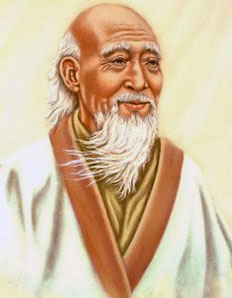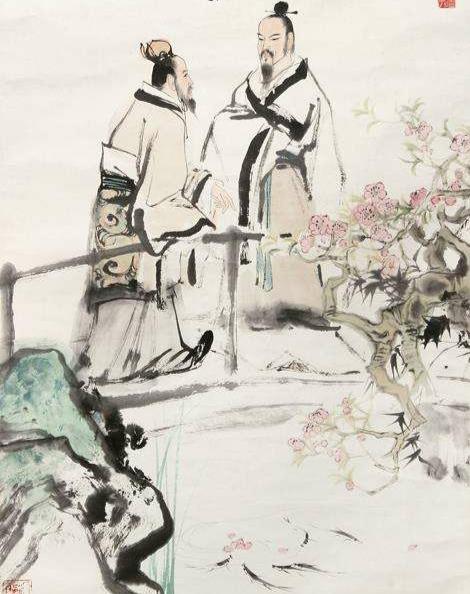
The character of great virtue follows alone from the Way.
As for the nature of the Way – it’s shapeless and formless.
Formless! Shapeless! Inside there are images.
Shapeless! Formless! Inside there are things.
Hidden! Obscure! Inside there are essences.
These essences are very real;
Inside them is the proof.
From the present back to the past,
Its name has never gone away.
It is by this that we comply with the father of the multitude of things.
How do I know that the father of the multitude is so?
By this.
(Translated by Robert Henricks)
Chapter 21 has been a challenge for the translators. Translations by Henricks, Red Pine, and DC Lau vary widely and are equally crypic, at least at first sight. I turned for help to Roger Ames & David Hall, whose translation is really a philosophical reformulation rather than a literary text.
I find the following comments in Red Pine’s book:
Wang Pi says: “Only when we take emptiness as our virtue can our actions accord with the Tao.”
Huang Yuan-Chi says: “Emptiness and the Tao are indivisible. Those who see the Tao cannot find it except through emptiness.”
Both Taoism and Mahayana Buddhism postulate emptiness as ultimate reality, but, whereas the word “emptiness” is ubiquitous in Buddhism, it is rarely seen in the Taoist foundational texts, which prefer to use the word Tao, and refer indirectly to Tao as “formless” or “shapeless.” This is the case in the first lines of chapter 21. The two commentators quoted by Red Pine, however, do use the word “emptiness” to refer to what Taoist practitioners rely on to find the Tao, the Way, to attune themselves with the workings of the Tao, on which they must model their actions. It is as if emptiness provided the de – virtue as power – and Tao provided the formless forms about to emerge into phenomena.
Instead of “the Way,” Ames and Hall use the word “way-making,” which turns it into a verb. Their own “translation” of chapter 21 begins as follows:
“Those of magnificent character (de)
Are committed to way-making (dao) alone.”
They write: “Way-making is participatory, and is thus influenced by the character of those who would act to extend it. While fluid and processual, it contains within it the eventful phenomena we identify as those “things” and “images” that make up our lives, including of course ourselves. This emerging field of experience is autogenerative, with the energy of transformation residing within it. The seminal concentrations of qi are fecund, giving birth to the myriad things around us, transforming as one thing becomes another. The underdeterminacy of these unique constituents makes their boundaries ever porous, but even more so at the beginning of their ascendancy and in their decline.”
Ames & Hall’s translation is:
“As for the process of way-making,
It is ever so indefinite and vague”
Again the word qi is absent from the chapter – I am not sure it is used anywhere in the Tao Te Ching -, but it may have been obvious to the readers of the time, that qi was involved in the process of way-making. When it is said that Tao gives birth to the ten thousand things, it was understood that it does so through qi, which is produced by the One, itself produced by Tao. Unlike Buddhism, which sees “things/events” arising out of the undifferentiated oneness of the world through co-dependent origination, an epistemological process, Taoism describes the emergence of the many as an energetic process.
Ames & Hall continue: “Way-making as the unfolding field of experience is the unsummed totality of things and events. It is unsummed because it is unbounded, and can only be known from one perspective or another. There is no single-ordered whole, no perspective outside of it.” To be counted, things and events would need to have sharp boundaries. And they only get sharp boundaries when they are “named” with concepts superimposed on their original formlessness. As experienced the world is a flow of interpenetrating phenomena, as described in the Huayan doctrine which Buddhism, which was obviously borrowed from Taoism. And it is heavily dependent on perspective. “Each of the foci that in total constitute experience is holographic in construing its own field of dynamic, transforming relationships.”
This corresponds to the following lines in Ames & Hall’s translation:
“Through vague and indefinite,
There are images within it.
Though indefinite and vague,
There are events within it.
Through nebulous and dark,
There are seminal concentrations of qi within it.
The concentrations of qi are authentic,
And have within them true credibility.”
Even though Taoism is a cosmology in a way Buddhism is not, still, Ames & Hall assert: “There is no single-ordered whole, no perspective outside of it.” There are only a multiplicity of perspectives ultimately based on experience. This is why chapter 21, along with a number of other chapters, ends with “By this” (yici). “The answer to the question, ‘How do we know that this is so?’ is ‘By this’. This question, rephrased, is ‘What is your perspective on this?’ … The emphasis in this Daoist epistemology of feeling, then, is neither the external environs as an object of knowledge nor the solitary knower as subject, but upon the site at which the act of knowing takes place, and the range and quality of relationships that constitute this site.”
Ames & Hall then ask: “Given the qualitative dimension of knowing, implicit in this question, “How?” … how productive is the knowing of the world in this way?” and they quote the famous story of Chuang-tzu (Zhuangzi) and the fishes.
“Zhuangzi and Huizi were strolling across the bridge over the Hao river. Zhuangzi observed, ‘The minnows swim out and about as they please – this is the way they enjoy themselves’.
Huizi replied, ‘You are not a fish – how do you know what they enjoy?’
Zhuangzi returned, ‘You are not me – how do you know that I don’t know what is enjoyable for the fish?’
Huizi said, ‘I am not you, so I certainly don’t know what you know; but it follows that, since you are certainly not the fish, you don’t know what I know is enjoyment for the fish either’.
Zhuangzi said, ‘Let’s get back to your basic question. When you asked ‘From where do you know what the fish enjoy?’ you already knew that I know what the fish enjoy, or you wouldn’t have asked me. I know it from here above the Hao river.’”
Ames & Hall continue: “Angus Graham, in interpreting this passage, observes that the expression anzhi can mean both “how do you know …” and ‘from where do you know … ‘ But Zhuangzi is not just depending upon this linguistic ambiguity in order to win a sophistical argument. He has a more philosophical point to make: He wants to deny the ‘objectivity’ of knowledge in the sense of the independence of the world known, from the knower.” In fact, in some Asian languages at least, the words used to refer to a “fact” is not the same whether you know the fact from hearsay or from an official source. Being raised in a social context that is so explicit with the need to assess information no doubt helps people avoid being caught up in statements arrived at through a mere rearrangement of concepts with no thought given to the realness of such fact at the level of experience.
Ames & Hall explain: “For Zhuangzi, knowledge is performative and a function of fruitful correlations. It is a ‘realizing’ of a world in the sense of ‘making it real’. And the knower and the known are inseparable aspects of this same event. Agency cannot be isolated from action. As the Zhuangzi says elsewhere, ‘There can only be genuine understanding when there is a genuine person’. One and one’s posture or perspective is thus integral to what is known. Knowledge entails proximity. Zhuangzi’s experience with the fishes makes his world continuous with the world of the fishes, and as such, his claim to knowledge is a claim to having been there.” Continuity, however, does not erase difference. “In fact, it only through Zhuangzi’s deference – allowing them to be what they are – that the experience can be optimally fruitful, and he can really come to know these particular fishes.”
This is why chapter 21, which started with an emphasis on Tao as “formless and shapeless” ends with a reference to the multitude of things.
“It is by this that we comply with the father of the multitude of things.
How do I know that the father of the multitude is so?
By this.”
Ames & Hall translate these three lines as:
“And it is through way-making that we can act in accordance with the sire of the many.
How do I know that the sire of the many is so?
By this.”
“The expression ‘sire of the many (zhongfu)’,” they comment, “balances the familiar metaphor for way-making ‘mother of everything that is (wanwu zhi mu)’, and ‘the mother of the heavens and earth (tianxia mu), underscoring the androgyny of the process. It should be noted that mother is the impregnated female, and father is the siring male. Each of them entails the other.”
Sources:
Robert G Henricks – Lao-Tzu, Te-Tao Ching
Roger T Ames and David L Hall – A philosophical Translation – Dao De Jing – Making this Life Significant”
Red Pine (Bill Porter) – Lao-tzu’s Taoteching

